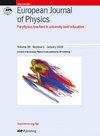钟摆周期的半经典计算
IF 0.8
4区 教育学
Q4 EDUCATION, SCIENTIFIC DISCIPLINES
引用次数: 0
摘要
摘要本文采用半经典路径积分法计算了经典摆的摆动周期。我们指出了经典周期轨道的重要性,以及摆的经典等时性与量子能级等距离的等价性。我们根据半经典隧穿时间和分数复活期导出了摆动期。提出了量子“反弹时间”临界值的可能定义。本文旨在为研究生提供一个将量子力学应用于经典系统的例证。它为了解经典摆和量子摆的一些共同特征提供了宝贵的见解。它还打算聘请一位量子化学专家,在量子化学中,量子摆动力学出现在一些化学键的阻碍旋转中。本文章由计算机程序翻译,如有差异,请以英文原文为准。
Semiclassical calculation of the Pendulum Period
Abstract. In this paper, we calculate the swing period of the classical pendulum via semiclassical path integration. We point out the significance of the classical periodic orbits and the equivalence of the pendulum’s classical isochronism to the equidistance of the quantum energy levels. We derive the swing period in terms of the semiclassical tunneling time and the fractional revival period. A possible definition of a critical value for the quantum “bounce time” is proposed. This paper intends for graduate students as an illustrating example of applying quantum mechanics to a classical system. It offers valuable insight into some characteristics that the classical and quantum pendulums possess in common. It also intends for a specialist in quantum chemistry where the quantum pendulum dynamics appears in what is known as hindered rotation about some chemical bonds.
求助全文
通过发布文献求助,成功后即可免费获取论文全文。
去求助
来源期刊

European Journal of Physics
物理-物理:综合
CiteScore
1.70
自引率
28.60%
发文量
128
审稿时长
3-8 weeks
期刊介绍:
European Journal of Physics is a journal of the European Physical Society and its primary mission is to assist in maintaining and improving the standard of taught physics in universities and other institutes of higher education.
Authors submitting articles must indicate the usefulness of their material to physics education and make clear the level of readership (undergraduate or graduate) for which the article is intended. Submissions that omit this information or which, in the publisher''s opinion, do not contribute to the above mission will not be considered for publication.
To this end, we welcome articles that provide original insights and aim to enhance learning in one or more areas of physics. They should normally include at least one of the following:
Explanations of how contemporary research can inform the understanding of physics at university level: for example, a survey of a research field at a level accessible to students, explaining how it illustrates some general principles.
Original insights into the derivation of results. These should be of some general interest, consisting of more than corrections to textbooks.
Descriptions of novel laboratory exercises illustrating new techniques of general interest. Those based on relatively inexpensive equipment are especially welcome.
Articles of a scholarly or reflective nature that are aimed to be of interest to, and at a level appropriate for, physics students or recent graduates.
Descriptions of successful and original student projects, experimental, theoretical or computational.
Discussions of the history, philosophy and epistemology of physics, at a level accessible to physics students and teachers.
Reports of new developments in physics curricula and the techniques for teaching physics.
Physics Education Research reports: articles that provide original experimental and/or theoretical research contributions that directly relate to the teaching and learning of university-level physics.
 求助内容:
求助内容: 应助结果提醒方式:
应助结果提醒方式:


